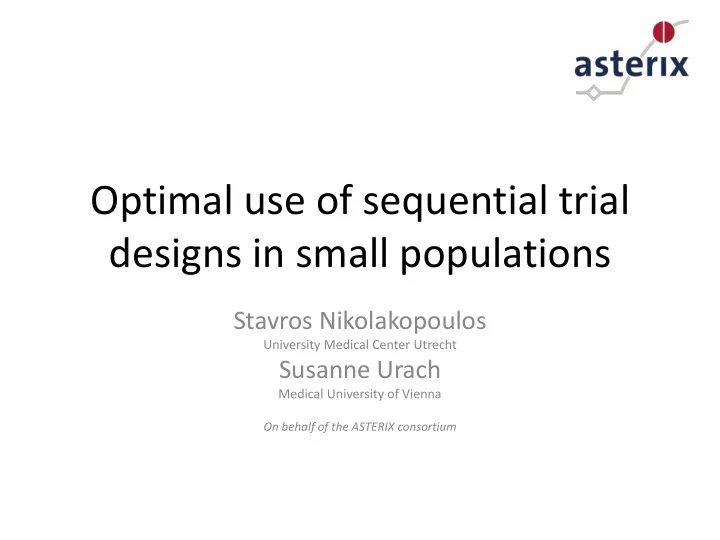

Optimal use of sequential trial designs in small populations Stavros Nikolakopoulos University Medical Center Utrecht Susanne Urach Medical University of Vienna On behalf of the ASTERIX consortium
Introduction • Group Sequential Designs (GSD) – Proper incorporation of interim stopping rules • Multiple looks at accumulating data increase type I – error compromise trial validity • Possibility of early stopping – Stopping for efficacy/futility – Faster access to effective treatments • Identified as top priority by patients (ASTERIX) – Faster dropping of ineffective/harmful treatments
GSDs in small populations Suggested by research and EMA/FDA guidance as potentially useful for • RCTs in small populations Reduction in sample size (study duration) key in small populations • Augustine EF, Adams HR and Mink JW, Clinical Trials in Rare Disease: Challenges and Opportunities, J Child Neurol, 2013
Design choices in GSDs • Boundaries – trade offs – Especially relevant with a small (maximum) sample size
Optimal boundaries For small sample sizes, frequently overlooked boundaries ( t- )correction is • essential – Type I error control Historical information may be utilized to derive optimal boundaries, given • maximum sample size and correction Incorporating uncertainty about parameters involved, given limited data – design prior – prior Nikolakopoulos S, Roes KCB and van der Tweel I, Sequential designs with small samples: Evaluation and recommendations for normal responses. Statistical Methods in Medical Research , 2016, epub ahead of print
Multi-arm GSDs Potential of multi-arm trials : • o Lower sample sizes than having separate trials for each treatment o Possibility of head to head comparisons between different treatments o More patients are randomized to a treatment arm due to the common control arm • Stopping rule: Separate stopping : o Treatment arms, for which a stopping boundary is crossed, stop. Simultaneous stopping : o If at least one null hypothesis can be rejected the whole trial stops. Simultaneous stopping ↔ trial objective: Separate stopping ↔ trial objective: Identify at least one treatment that is superior to control. Identify all treatments that are superior to control .
Simultaneous stopping in multi-arm GSDs Advantages Disadvantages Randomizing to control group as soon as an Lower power to reject all null hypotheses • • efficacious treatment has been found is unethical in ( conjunctive ) life threatening diseases The simultaneous stopping rule must be adhered • Lower expected sample size to • Same power to reject any null hypothesis If improved boundaries are used • • Stopping only based on efficacy endpoint, ( disjunctive ) • treatments might differ in safety Improved boundaries can be applied to regain some • Less information available about all treatments of the power to reject all null hypotheses • Urach S and Posch M, Multi-arm group sequential designs with a simultaneous stopping rule. Statistics in Medicine, 2016, 35: 5536–5550
Conclusions • GSDs points of attention when implemented in a small population setting • Particularly in small populations, any reduction in sample size could translate to significant benefit (time) • Boundaries can be optimized for – Historical information Design prior taking logistical concerns & correction into account • – Inferential goal For simultaneous stopping, lower ASN is possible (fixed disjunctive power) • Some of the conjunctive power can be regained by relaxed boundaries •
Discussion points • Suitability of GSDs for small populations (rare diseases) • Issue of trade off efficiency/ information gain magnifies • In chronic conditions with high unmet need / organised patients, recruitment might be fast (despite small samples) • Response time / Recruitment ratio crucial • Diseases classification (WP5) of importance for design implementation
Recommend
More recommend